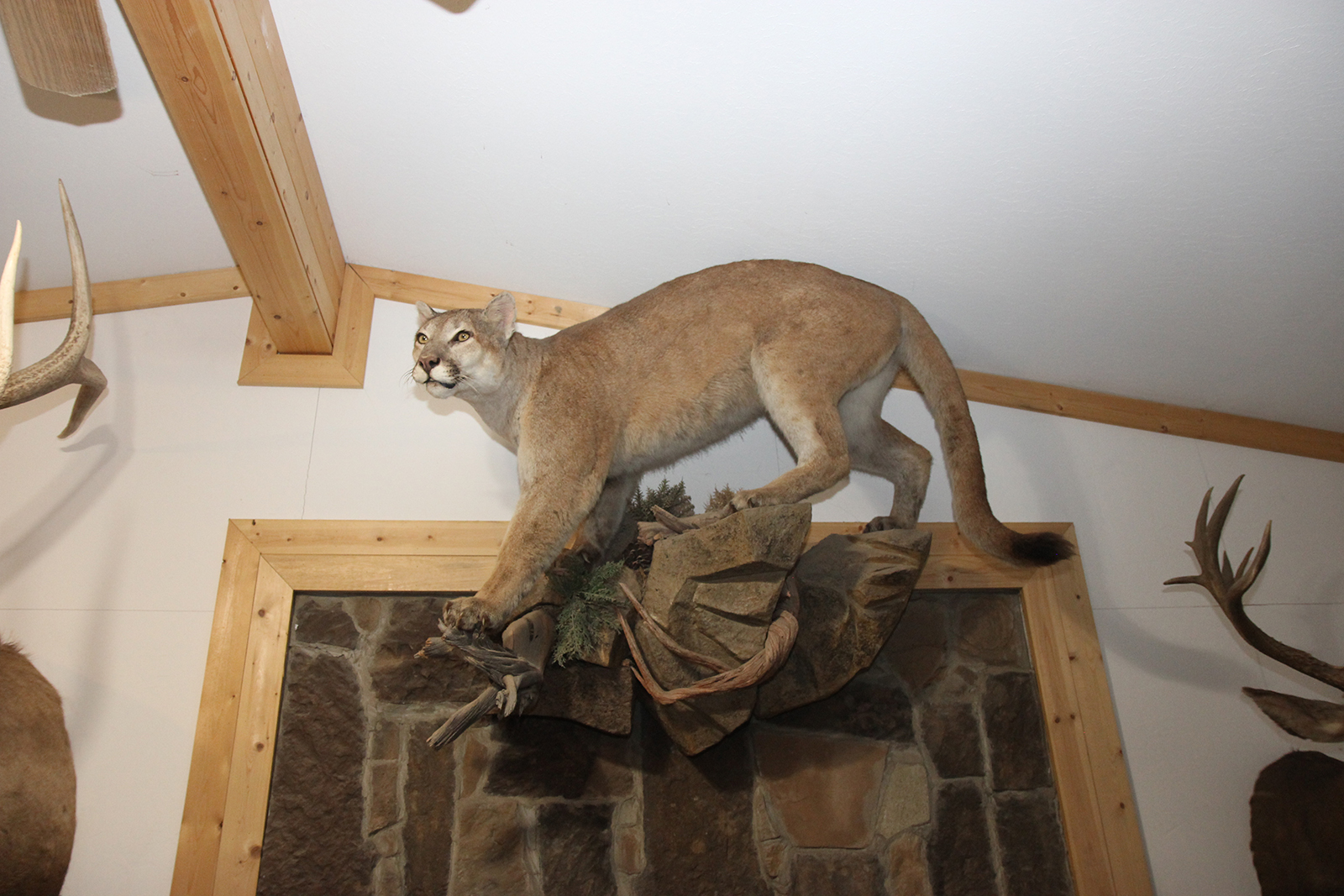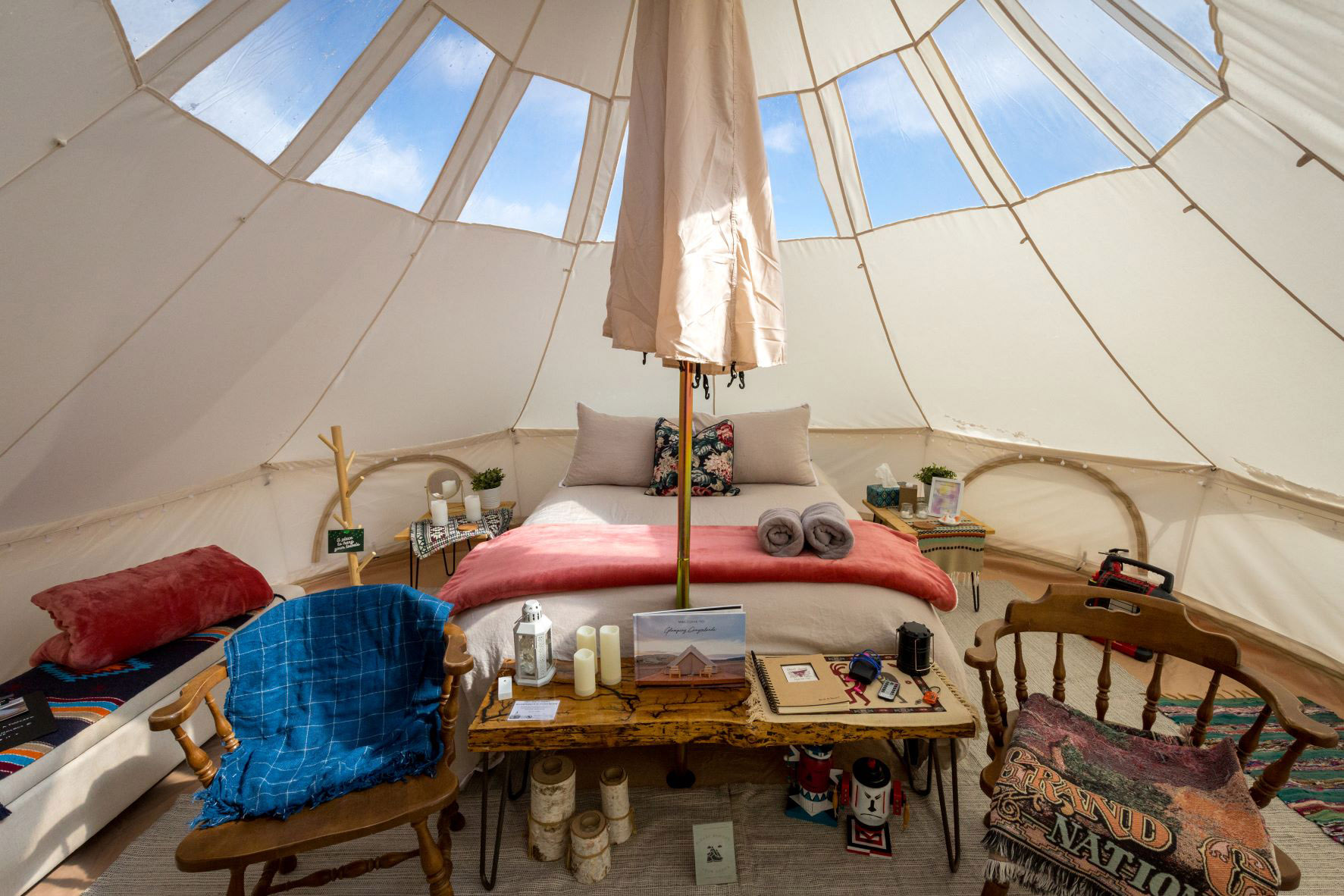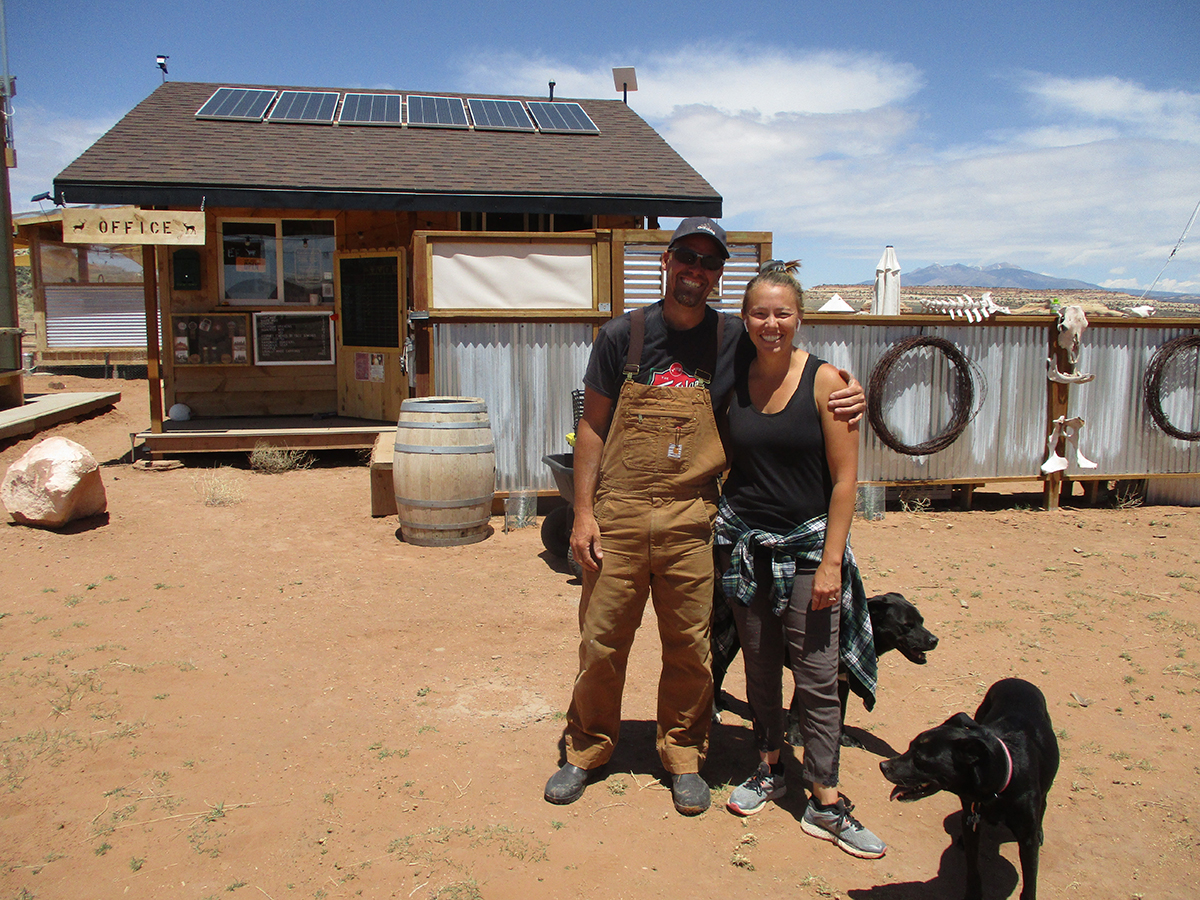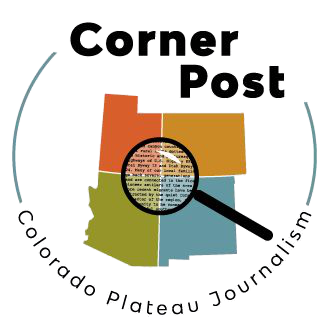
In-Depth
Getting a Grip on Glamping
A new lodging niche challenges planners in southern Utah


by Rachel Fixsen – 07.14.2022 – 20 min. read
State Route 211 traverses rolling desert shrubland in Southeast Utah, passing rust and buff-colored sandstone domes and the foothills of the Abajo Mountains before winding down into the Indian Creek valley.
In 2020, a new development joined the few structures peeking out from among the shrubs: several canvas tents on wooden platforms, a small wooden office building, a shared outdoor kitchen and a bathroom facility. Branded as Glamping Canyonlands, the modest resort is open seasonally to guests interested in exploring the area in comfort while staying remote and off-grid.
Owners Keshia and Erik Joot built much of the development themselves, and live on-site.
“The first thing we think about is the land…and of course, how the guest experience is,” Keshia Joot said.
But that experience is on the brink of some big changes and, the Joots fear, not for the better.
Across the road from Glamping Canyonlands, San Juan County planners have approved a conditional use permit for another glampground on a much bigger scale. The proposed George Eco Luxury Hotel Resort development has 82 wood-and-glass “eco-domes,” a restaurant, spa, movie dome, pool, wedding dome, and employee housing. The developer, Clear Sky Resorts, has two other resorts near Glacier and Grand Canyon national parks.
At a Jan. 13 San Juan County Planning Commission meeting, the Joots brought up their concerns about the scope of the proposal: its potential effects on dark night skies, the prospect of noise and dust, its intrusion on the view and the effects of its wells on the local water table.
“Something that large is insane out here, it’s absolutely nuts,” Keshia Joot said.
“Glamping” (a portmanteau of “glamorous” and “camping”) proposes to combine a remote experience in nature with the luxury of upscale lodging. Canvas yurts are a popular format; glamping might also mean tree houses, “pods,” safari tents, tipis, domes, cabins, huts, igloos or other unusual structures. The niche industry has picked up considerable momentum in recent years: according to GlobalNewsWire, the U.S. glamping market was valued at $569.21 million in 2020, and is projected to grow at an annual rate close to 20%.
The Western states account for the biggest share of the market, and the “Mighty Five” national parks in southern Utah make the region especially attractive for glamping developments, but the sector’s growth is outpacing some communities’ capacity to analyze and plan for them.
Glampgrounds don’t fit neatly into most code definitions of hotels, campgrounds, or RV parks. The concept of a glampground—that one can enjoy luxury in the middle of nowhere—means lodging and services are installed in places that were otherwise undisturbed. The range of projects that can fall under the loose term “glampground” is huge—from a few off-grid tents to hundreds of temporary or permanent structures each with plumbing and electricity, sometimes complemented by resort features like pools and restaurants.

San Juan County does not have an ordinance specifically addressing glampgrounds. A draft ordinance proposed to update the county’s entire land-use code—scheduled for consideration later this summer—however, defines glamping as lodging “where guests can experience the positives of camping without the ‘uncomfortable’ negatives.” Glampgrounds are grouped with other styles of short-term rentals in the draft and are a permitted use in agricultural and multiple-use zones and a conditional use in highway commercial and rural recreational protection zones.
Currently, glamping developments are classified as resorts, and considered by the planning commission for conditional use permits on a case-by-case basis. And that’s how the body approved Clear Sky’s George Eco Luxury Hotel Resort.
Joot thinks the county could use more nuanced ordinances to govern developments as the market evolves. She and a couple of other neighbors have teamed up to appeal the Clear Sky Resorts permit approval through a county process, aiming to have the size of the development reduced.
Scott Burton, the planning and zoning administrator for San Juan County, said his department has been seeing an increase in building permit applications of all kinds, including glampgrounds and other tourism industry developments, like RV parks.
“Having the Bears Ears Monument designation, it definitely seems to have increased tourism traffic and tourism interest in the area,” Burton said. He also noted that as nearby Moab becomes increasingly crowded, tourists are starting to spread out. Covid, too, has helped drive people to outdoor vacations.
“I think all of those things are kind of a factor,” he said. “It kind of has just become a ‘thing’— people are wanting to have that kind of experience.”
Burton noted that while San Juan County has no specific glamping ordinance, the developments are subject to the same requirements as any other campground or resort, including a system for waste management. Glamping Canyonlands had to install a septic system to meet county code, a change of plans from the composting toilet they’d envisioned at their resort. Requirements for potable water can also be hard to meet in rural, arid areas.
“I’ve had quite a few phone calls where people say they want to do a glamping resort,” Burton said. “There’s a lot of people that throw stuff against the wall and it doesn’t seem to stick.” Just a “handful” have actually gone through the process, he said.
The most successful applicants are larger companies with capital and experience, such as Clear Sky Resorts.
The Clear Sky Resorts development is not the first proposed glampground to raise concerns with neighbors, the public, or local officials. Over 35,000 people signed a petition opposing a proposed glampground with hundreds of units called Above Zion, near Zion National Park, accessed from a remote and winding road. Park Superintendent Jeff Bradybaugh also raised concerns about traffic, water rights and wildlife disruption at an October 2021 Washington County Planning Commission meeting.
A large glamping company called Under Canvas also has generated pushback over its plans to build 75 yurt-style tents on 13 acres about a quarter mile from Looking Glass Rock in San Juan County. A grassroots petition opposing the deal, driven by concerns that the project would forever damage the remote atmosphere of the prized recreation area, gathered over 2,800 signatures but did not deter Under Canvas and landowner Utah School and Institutional Trust Lands Administration from proceeding with the deal.

Under Canvas has raised other concerns: In June of 2021, reporter Zak Podmore wrote in The Salt Lake Tribune about a septic system failure at the company’s Moab location, which is in a minimally developed desert area north of the city. The company called the incident an isolated issue and said it was promptly addressed despite claims by former employees that problems emerged over a prolonged period. A state report said the Utah Division of Water Quality verified the cleanup with the Southeast Utah Health Department on June 9, 2021.
Moab resident Dailey Haren, who spearheaded the petition against the Looking Glass-adjacent development, said she sees glamping overall as a negative, an exploitation of untouched wild spaces that don’t lend themselves to more traditional development. She added that the most luxurious glampgrounds, which may include private bathrooms and climate control in each individual unit, are much less efficient than traditional buildings.
“Bottom line, these developments are trendy high-profit cabins made out of canvas providing hotel-like amenities while operating under the false guise of camping, taking advantage of a fast moving trend to develop finite open spaces in a way that is improperly regulated and reckless,” Haren wrote in an email.
Under Canvas also has resorts near Lake Powell and Zion, as well as locations in several other states. The company is slated to open yet another location this summer near Bryce Canyon National Park in Garfield County.
Garfield County, which also contains parts of Capitol Reef National Park and Grand Staircase-Escalante National Monument, created a glamping ordinance in the spring of 2019 —the first Utah county to do so.
The ordinance prohibits the use of units as permanent residences, and specifies that glampgrounds are allowed in commercial and multiple use zones; they’re a conditional use in resort recreation and agricultural zones.
Garfield County glampgrounds can’t be any denser than 10 units per acre and are capped at 100 units total. The developments must be located near a maintained road and “adequate” recreation facilities, and be accessible to emergency services. The ordinance refers to requirements set by health and environmental agencies to govern potable water, sanitary and wastewater systems. The new Under Canvas location, for example, will drill a well and install a septic system for waste.
Garfield County Planner Kaden Figgins said the ordinance was necessary to address an influx of glamping-style applications. Like Burton, however, Figgins said he gets a lot more inquiries than serious proposals.
“Most people calling are dreamers,” Figgins said. Many people think they can build a glampground for cheap—$10,000 or $20,000, Figgins said—and get a quick return. What they don’t realize is that waste, potable water, and road access are all significant obstacles to development in rural Utah. Garfield County requires a septic system for waste; there are virtually no water rights available in the county; and, Figgins said, most properties that could be a glampground site have no existing road access.

The ordinance is not intended to limit new glampgrounds in Garfield County. In fact, Figgins welcomes the new Under Canvas site, which will open its first phase after the construction of 50 tents, each with a private bathroom. Rates will start at about $350 a night. Another 50 units are proposed for phase two and plans for a third phase include more luxurious tents that could cost as much as $1,000 a night. The county’s current glamping code would have to be amended, or an exemption created, to allow for that third phase to happen.
“They’ll probably bring a lot of [transient room tax] and sales tax revenue to the county, but they’ve also been just great for the community,” Figgins said, noting that Under Canvas has purchased several homes in Panguitch and Tropic to use as employee housing, and that they’ll offer jobs to locals at higher-than-average wages. Figgins is upbeat about how the company’s $7.5 million investment in Garfield County could help its economy.
Other Utah counties have followed Garfield County’s lead in creating glamping ordinances. Piute County’s ordinance is closely modeled after it. Kane County has incorporated glamping into its land-use code, allowing glamping as a conditional use in its agricultural, rural and commercial zones.
While new development is seen as a boon in many parts of rural southern Utah, residents in other areas are feeling overwhelmed by the pace of growth.
In Grand County, for example, hotels and tourism businesses have proliferated while a dearth of housing options for local workers has created a crisis. County leaders have tried various tactics to spur the development of affordable housing, including requiring new overnight rental projects to offer assured workforce housing in order to get approval. Campgrounds, though, are exempt from this requirement under current code. The county is currently undertaking a broad overhaul of its land-use code, and some or all campgrounds (or glampgrounds) may be subject to the assured housing requirement after the revision.
Grand County doesn’t have a glampground ordinance, though it is receiving applications for glamping-style projects. Planning Administrator Elissa Martin said the county has received three this year, two using tent-style structures and one using small cabins. The county has removed any kind of overnight accommodations—hotels or campgrounds—as a permitted use in any zone; such developments must be considered by the county commission, and approval is based on how well those developments meet a set of desired criteria. Two of the three glampground applications were approved.
Grand is also working on defining glampgrounds in its code. Martin said officials are envisioning them as small developments with some kind of theme or purpose beyond just accommodation. For example, one of the approved glampgrounds brands itself as an astronomy education center and plans to offer guided stargazing.
One proposed high-end glampground along the north entry corridor into Moab (which was not approved) would have had significant impacts compared to some smaller glampgrounds—including a pool and clubhouse in an undeveloped area with limited water resources. At the same time, it offered a plan to put hundreds of acres of privately-owned open space into a conservation easement.
The proposal could return to the County Commission with a more favorable vote if the land-use code update allows the county to legally bind the developer to its conservation easement promise, something not provided in the current code.
While glamping isn’t an entirely new concept, it is newly fashionable, and developers are eager to take advantage of untapped acreage in scenic landscapes. Planners across the Four Corners area will have to be as adaptive and creative as the newest resorts.
Republish
Republish Our Content
Corner Post's work is available under a Creative Commons License and under our guidelines:
- You are free to republish the text of this article both online and in print (Please note that images are not included in this blanket licence as in most cases we are not the copyright owner) but:
- you can’t edit our material, except to reflect relative changes in time, location and editorial style and ensure that you attribute the author, their institute, and mention that the article was originally published on Corner Post;
- if you’re republishing online, you have to link to us and include all of the links in the story;
- you can’t sell our material separately;
- it’s fine to put our stories on pages with ads, but not ads specifically sold against our stories;
- you can’t republish our material wholesale or automatically—you need to select stories to be republished individually;
- you have to credit us, ideally in the byline; we prefer “Author Name, Corner Post,” with a link to our homepage or the article; and
- you have to tag our work with an editor’s note, as in “This article was paid for, developed, and originally published by Corner Post. Corner Post is an independent, nonprofit news organization. See cornerpost.org for more.” Please, include a link to our site and our logo. Download our logo here.
 Rachel Fixsen
Rachel Fixsen
Rachel Fixsen is a resident of Moab, Utah. She currently writes for the Moab Sun News and works on a construction crew on the side. She has an undergraduate degree in English from the University of Maryland and has worked for the National Park Service as a wilderness ranger and the Bureau of Land Management as a wildland firefighter. When she’s not working, she loves rock climbing, trail running, biking and hiking, as well as baking chocolate chip cookies. Lately, she’s been trying her hand at growing vegetables.

 Corner Post is a member of the Institute for Nonprofit News—a nationwide network of independent, nonprofit, nonpartisan news organizations. Learn more at
Corner Post is a member of the Institute for Nonprofit News—a nationwide network of independent, nonprofit, nonpartisan news organizations. Learn more at  Our stories may be republished online or in print under
Our stories may be republished online or in print under 
1 thought on “Getting a grip on glamping”
Thank you for this interesting article, I enjoyed reading it. I agree that “glamping” needs its own set of commercial regulations to manage impacts to fragile areas. It would also make sense to require developers to post a “reclamation bond” of some type to insure that failed operations aren’t abandoned as blights on local communities and landscapes.